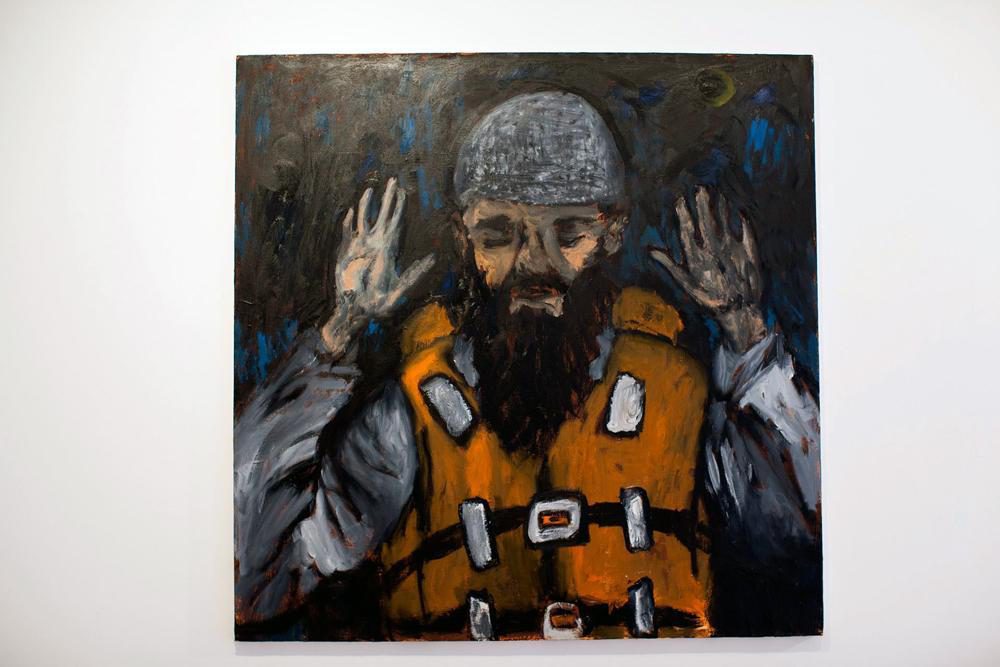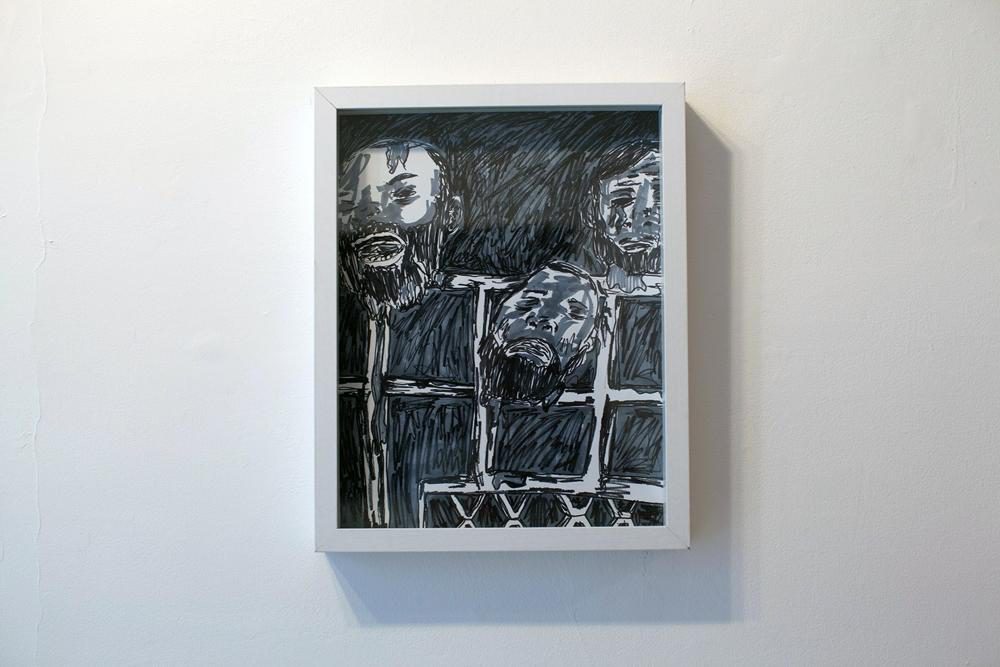“God Willing”: An Interview with John Isiah Walton
Benjamin Morris speaks to New Orleans native John Isiah Walton about his recent paintings and drawings, which look at the ongoing conflict in Syria.

John Isiah Walton, Allah, I lift my hands, 2016. Oil on canvas. Courtesy the artist and P339, Brooklyn.
Editor's Note
As part of our ongoing series in conjunction with “False Flags,” we’ve been showcasing the work of artists whose practices explore the complex questions surrounding national identity, borders, patriotism, and migration. Last month, painter John Isiah Walton, a native of New Orleans, opened a show at P339 in Brooklyn, New York, featuring nine pieces depicting the plight of Syrian refugees. Benjamin Morris speaks to Walton about this body of work.
Benjamin Morris: How did your interest in this subject matter first arise?
John Isiah Walton: As a young adult, I was absorbed in the events of Hurricane Katrina back in 2005 and, at the time, was heavily influenced by news-media depictions of what was happening here. My family actually ended up in Houston, and while at the Convention Center there I kept hearing people talk about how homesick they were for the brick housing projects of New Orleans, like the B.W. Cooper projects. It struck me—that intense homesickness.
But fast-forward a few years to the conflict in Syria. Seeing the images of people on water fleeing others who were destroying their homes due to religious beliefs reminded me of the experience of seeing my friends fleeing their homes on water during Katrina. I felt a connection between us, except that during Katrina, we were being called refugees when we were actually from here.
BM: How did the show come about?
JIW: I did a show with P339 last year. We had been discussing ideas for new work about six months ago surrounding the idea of inshallah, which translates as “God willing.” The owner’s parents are from the Middle East so he really wanted to do this. For the show, we hung nine pieces—five drawings and four paintings—and a portion of the proceeds from the sale of the work will go to support Syrian refugees currently living in Beirut.
BM: Given the scale of the crisis, you could have chosen any number of areas to focus on. How did you select the subject matter for these works?
JIW: Well, as a kid, I was always interested in other cultures. I used to read encyclopedias cover to cover—this was in the days before the Internet, Google and Wikipedia—and I was always interested in other places. That’s how I learned about Byzantine mosaics, Michelangelo and Italian art, Japanese culture, and others. As an adult, however, inspiration can strike at any moment, and like Basquiat, I try to stay open to new sources.
Vice News had a series on the stories of Syrians—people fighting, people lost at sea in Greece, people finding refuge in Germany. I read many of these and tried to imagine what these scenes looked like. Originally I was going to do a much larger book called The Disaster of Holy War, but I scaled it back—I wanted to focus less on brutality and more on the stories that don’t always get told. Stories like trying to find a place to live after reaching safety.
For one work, I found a photo of a man praying at a mosque. I took that and added my own elements, including adjusting the light and the kind of life vest he wore. It was like surgery, piecing all those elements together. It’s like playing God—you’re creating a reality for these people in the painting. Honestly, it’s the worst possible thing to do.

John Isiah Walton, Enemies of the State, 2016. Ink on paper. Courtesy the artist and P339, Brooklyn.
BM: How did you think about your style—your choices of brushwork, composition, palette?
JIW: I created around 30 or 40 images for the whole series. I didn’t want any clichéd images. I researched the images online, getting ideas from different sources, but ultimately I wanted to go towards an aesthetic like Goya’s etchings, or van Gogh or El Greco’s paintings. I felt like this series could have ended up either very classical or very abstract, but I wanted to offer more detailed renderings and backgrounds than I had recently explored in my Angola prison rodeo series.
To my mind, competing with the camera is the number one thing. Picasso broke through his medium working with all styles—realistic, Surrealist, blocky, loose—but he was also well aware of the camera. Representing real life and abstracting it is the challenge for all artists. But paintings can make you want to read them.
BM: Regrettably, many governors of Southern states have closed their doors to receiving any refugees from the Syrian crisis, insisting that they find somewhere else to live. How do you think the arts can shift this discourse or contribute to this conversation?
JIW: I saw this with 9/11, when people who were Muslim were being branded as the enemy. Now, of course, Donald Trump is making those fears come true. We artists are reporters also—we’re documenting our times. These people are vulnerable and need our help—Goya and Picasso saw the same thing in their time, after their disasters, with The Third of May and Guernica. The problem is now we get flooded with so many images, one after another, that it’s hard to process them all without tuning them out. The other problem is that some artists who explore these issues just want to make money and not actually get involved in a political situation.
As for the reaction to these works, some people really like them, but others think they’re crazy. In creating work, though, once it’s out there, I let it go off and have a life of its own, because as long as I gave it my best shot in telling that story, that’s all I can do. As long as I created the best work possible, I’m good.
BM: Following this series, what will you be working on next?
JIW: My next project will look at the Keirin bicycle races in Japan, which have incredible forms and very cool colors. Following that, I’d like to do a series on nomadic livestock herders in Tibet, hopefully some very large-scale work. The Chinese government is trying to round them up and crack down on their traditions, though, so it’s complicated. In the past I’ve tried to stay away from political topics, but it’s unavoidable. The main problem is that I’m much worse at painting pretty pictures.
Editor's Note
John Isiah Walton’s “God Willing” is on view through May 14, 2016, at P339 (339 Bedford Avenue) in Brooklyn.



